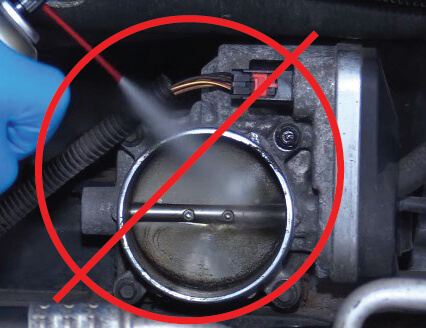Honda throttle body cleaning and reset
How to perform a Honda throttle body cleaning and Honda throttle body reset
This article pertains to Honda throttle body cleaning and a Honda throttle body reset. All electronic throttle bodies accumulate carbon buildup on the throttle plate and bore—the Honda throttle body is no exception.
The carbon accumulates after the engine is shut down and is caused by hot oil and gas vapors rising to the top of the engine where they collect on the cooler throttle body.
How an electronic throttle body works
In carbureted engines, the idle screw kept the throttle

Carburetor throttle plate
plate cracked open slightly to allow air into the engine. That airflow created vacuum in the carburetor’s venture, which drew in gasoline to keep the engine running. When carmakers switched to fuel injection, the purpose of the throttle body change to operate more like an air valve, allowing more air into the intak manifold as you put the pedal to the metal. To provide air at idle, carmakers installed an idle air bypass valve that allowed air to flow around the closed throttle plate. The fuel injectors provided the fuel and the bypass valve regulated airflow.
But electronic throttle bodies don’t have an idle air bypass valve, and they don’t use a throttle cable. Instead, these are “fly by wire”

Electronic throttle body and accelerator pedal position sensor
systems where the movement of the accelerator pedal translates into an electronic input signal to the engine computer, which then commands the electronic throttle body to open or close by a certain amount. The throttle plate shaft is connected to a small motor and spring that responds to inputs from the computer.
At idle, the computer commands the throttle plate to crack open slightly, much like the old carburetors. This feature eliminates the need for an idle air bypass valve. When the engine is off, the throttle plate is fully closed. That’s where the carbon buildup becomes a problem.
Symptoms of throttle body carbon buildup
When the vehicle computer commands a certain

Remove carbon buildup from the bottom of the throttle plate
throttle plate opening, it expects a certain amount of air to flow between the throttle plate and throttle bore. But as carbon builds up and reduces that space, the engine becomes air starved. The computer can detect the lower airflow based on inputs from the mass airflow sensor and commands an even larger throttle plate opening. But at a certain point of carbon buildup, the computer can no longer compensate.
The result is a rough idle, stumble on acceleration or a dying engine. That’s when the carbon must be removed.
Shops sell induction service to correct the problem
In the old days of mechanical throttle bodies, the shop would simply crack open the throttle body by hand and shoot in some aerosol throttle body cleaner. Then they’d wipe with a rag to remove the carbon and you’d be on your way. You can’t use that technique with an electronic throttle body, because the spray cleaner can flow along the throttle plate shaft and into the motor housing and circuit board areas, causing complete failure.
Shops sell routine induction service as a way to boost profits. That’s a scam. You don’t need routine throttle body cleaning because your car’s computer is designed to adapt to normal carbon buildup issues. Pay for induction cleaning ONLY when you’ve got a performance issue like a rough idle or stumble on acceleration.
Honda throttle body cleaning
Due to the sensitive electronics in the electronic throttle body housing, all carmakers, including Honda, recommends removing the throttle body from the engine before cleaning. Once off the engine, set the throttle body on a clean shop rag with the electronics facing up.
Slowly open the throttle plate and begin cleaning by spraying the aerosol cleaner on a clean soft rag and wiping the solvent onto the throttle plate and throttle bore. NEVER spray the solvent directly onto the throttle plate. Also, never use abrasive scrubbing pads or brushes to remove the carbon buildup.

Never spray throttle body cleaner into an electronic throttle body while it’s still on the engine
Perform a Honda throttle body relearn
Reinstall the Honda throttle body using a new gasket and torque to specifications. Now that the carbon buildup is gone, you must “teach” the computer where the fully closed position is. This is called a Honda throttle body relearn or Honda throttle body reset.
Shops perform a Honda throttle body reset with a scan tool, but you can perform it manually by following this procedure:
1) Turn the ignition key to the RUN position for 2-seconds. Do not start the engine.
2) Start the engine and run it at 3,000 RPM until the radiator fans come on.
3) Then let the ending idle for five minutes with no loads (lights, heated seats, rear defogger, blower motor, radio, etc OFF)
4) After five minutes, shut off the engine.
©, 2017 Rick Muscoplat
Posted on by Rick Muscoplat
